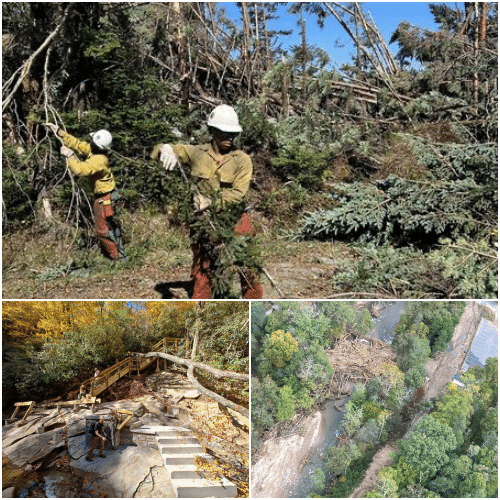Last Updated on November 1, 2024 4:11 pm
ASHVILLE, N.C. (Nov. 1, 2024) – The USDA Forest Service today released its preliminary data on the ecological impacts and infrastructure damage caused by Tropical Storm Helene on the Nantahala and Pisgah National Forests in North Carolina.
Using information sourced from satellite data, aerial surveying and on-the-ground assessments, analyses found that Tropical Storm Helene caused moderate to catastrophic damage to more than 187,000 acres of both forests (roughly 20 percent of the total acreage), including 117,000 acres of vegetation loss.
The bulk of the damage occurred on the Pisgah National Forest, particularly in areas within Yancey, Mitchell, McDowell, and Avery counties, where several communities neighboring the forest were devastated by the storm. Two of the three districts on the Pisgah, the Grandfather and Appalachian Ranger Districts, remain closed while the response to the storm continues.
The loss of such a large portion of the ecosystem can have several negative effects, such as the threat of wildfire due to increased fuel levels, loss of vital wildlife habitat, impacts on watershed health and the higher potential for invasive species to thrive.
“Immediately after the storm, we focused our efforts on helping first responders and emergency personnel gain access to isolated communities and critical infrastructure,” said Forest supervisor James Melonas. “But now that we’ve had an opportunity to evaluate the best data available, we can begin to piece together a clearer picture of the sheer scale of the damage to our National Forest land. This is a recovery that will be measured in years.”
In addition to the ecological damage to the two National Forests, nearly 900 miles of Forest Service-managed roads and an estimated 800 miles worth of trails have been damaged, with several completely washed away or remained blocked by debris. It’s anticipated that those numbers will increase as roadways are cleared and further assessments can be completed. Forest Service crews continue to work to remove debris and downed trees covering impacted roads and improve access throughout the National Forests.
“Our crews are hard at work clearing debris from roads and recreation areas, but we have many areas of the forest that we simply have no means to access right now. We need the public to continue staying off all closed portions of the forest until we can finish clean-up efforts and complete assessments,” said Melonas. “Everyone in western North Carolina is passionate about our public lands, and by working with our community of partners, from local and state agencies to nonprofits, we will soon begin mapping our path toward long-term recovery.”
For the latest information on Helene-related closures and updates, visit https://www.fs.usda.gov/nfsnc or follow @nfsnc on Facebook.
| Black Mountain Campground on the Pisgah National Forest, Appalachian Ranger District. The bridge leading to the campground over the S. Toe River was significantly damaged by Tropical Storm Helene. |
 Assessing damage to the Catawba Falls Recreation Area after Tropical Storm Helene. Assessing damage to the Catawba Falls Recreation Area after Tropical Storm Helene. |
 |
| A crew with the Forest Service Job Corps Civilian Conservation Center clearing downed trees and debris from the Roan High Knob area. |

